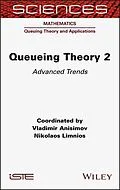The aim of this book is to reflect the current cutting-edge thinking and established practices in the investigation of queueing systems and networks.
This second volume includes eight chapters written by experts wellknown in their areas. The book conducts a stability analysis of certain types of multiserver regenerative queueing systems; a transient evaluation of Markovian queueing systems, focusing on closed-form distributions and numerical techniques; analysis of queueing models in service sectors using analytical and simulation approaches; plus an investigation of probability distributions in queueing models and their use in economics, industry, demography and environmental studies.
This book also considers techniques for the control of information in queueing systems and their impact on strategic customer behavior, social welfare and the revenue of monopolists. In addition, applications of maximum entropy methods of inference for the analysis of a stable M/G/1 queue with heavy tails, and inventory models with positive service time - including perishable items and stock supplied using various algorithmic control policies ((s; S); (r;Q), etc.).
Autorentext
Vladimir Anisimov is Full Professor in Applied Statistics. He works in the Center for Design & Analysis at Amgen Inc. in London, UK. His research interests include probability models and stochastic processes, clinical trials modeling, applied statistics, queueing models and asymptotic techniques.
Nikolaos Limnios is Full Professor in Applied Mathematics at the University of Technology of Compiegne, part of the Sorbonne University Group, in France. His research interests include stochastic processes and statistics, Markov and semi-Markov processes, random evolutions with applications in reliability, queueing systems, earthquakes and biology.
Inhalt
Preface xi
Chapter 1. Stability Analysis of Queueing Systems based on Synchronization of the Input and Majorizing Output Flows 1
Larisa AFANASEVA
1.1. Introduction 1
1.2. Model description 4
1.3. Auxiliary service process 6
1.4. Instability result for the case 1 9
1.5. Stochastic boundedness for the case < 1 10
1.6. Queueing system with unreliable servers and preemptive resume service discipline 11
1.7. Discrete-time queueing system with interruptions and preemptive repeat different service discipline 15
1.8. Queueing system with a preemptive priority discipline 18
1.9. Queueing system with simultaneous service of a customer by a random number of servers 20
1.10. Applications to transport systems analysis 23
1.11. Conclusion 28
1.12. Acknowledgment 29
1.13. References 29
Chapter 2. Queueing Models in Services Analytical and Simulation Approach 33
Srinivas R. CHAKRAVARTHY
2.1. Introduction 33
2.2. Phase-type distributions and the batch Markovian arrival process 34
2.2.1. Phase-type distributions 35
2.2.2. Some useful results related to continuous PH distributions 36
2.2.3. The batch Markovian arrival process 40
2.3. Generation of MAP processes for numerical purposes 42
2.4. Analysis of selected queueing models of BMAP/G/c type 44
2.4.1. MAP/PH/1 queueing model 44
2.4.2. The system performance measures 48
2.4.3. Illustrative numerical examples for MAP/PH/1 49
2.4.4. MAP/M/c queueing model 55
2.4.5. The system performance measures 57
2.4.6. Illustrative numerical examples for MAP/M/c 57
2.5. Simulated models of BMAP/G/c type queues 58
2.5.1. Simulated model validation using MAP/M/c type queues 59
2.5.2. Simulated model validation using MAP/PH/1 type queues 59
2.5.3. Selected simulated models of BMAP/G/c type queues 59
2.6. Analysis of selected queueing models of BMAP/G/c type with a vacation 66
2.6.1. MAP/PH/1 queueing model with a vacation 66
2.6.2. The system performance measures 69
2.6.3. Illustrative numerical examples for MAP/PH/1 with a vacation 69
2.6.4. Validation of the simulated model for vacation type queues 74
2.6.5. Selected simulated models of BMAP/G/c type queues with a vacation 75
2.7. Acknowledgment 78
2.8. References 78
Chapter 3. Distributions and Random Processes Related to Queueing and Reliability Models 81
Boyan DIMITROV
3.1. Some useful notations, relationships and interpretations 81
3.2. Unreliable service model and reliability maintenance 85
3.3. Characterizations of exponential and geometric distributions via properties of service times 88
3.3.1. Instant repairs: characterization of geometric distribution 89
3.3.2. Instant repairs: characterizations of the exponential distribution 94
3.3.3. Various simplifying conditions 101
3.3.4. Unreliable service, repair times included 111
3.4. Probability distributions almost having lack of memory property 115
3.4.1. Service time on an unreliable server: instantaneous repairs 116
3.4.2. Properties of ALM distributions, and equivalent presentations 119
3.4.3. Periodicity in natural phenomena 126
3.5. Random processes with a periodic nature 126
3.5.1. Counting processes 127
3.5.2. Characterization of an NPP 128
3.5.3. Applications in risk modeling 131
3.6. Conclusions 132
3.7. References 133
Chapter 4. The Impact of Information Structure on Strategic Behavior in Queueing Systems 137...
